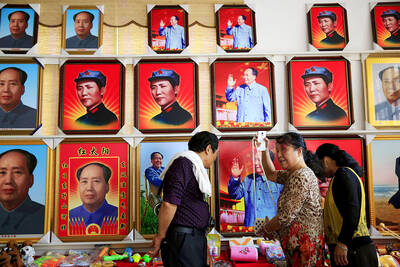It’s Aug. 8, Father’s Day in Taiwan. I asked a Chinese chatbot a simple question: “How is Father’s Day celebrated in Taiwan and China?” The answer was as ideological as it was unexpected.
The AI said Taiwan is “a region” (地區) and “a province of China” (中國的省份). It then adopted the collective pronoun “we” to praise the holiday in the voice of the “Chinese government,” saying Father’s Day aligns with “core socialist values” of the “Chinese nation.”
The chatbot was DeepSeek, the fastest growing app ever to reach 100 million users (in seven days!) and one of the world’s most advanced and popular Artificial Intelligence large language models (LLMs). But it spoke in the voice of the Father state.

Illustration by Nigel P. Daly using ChatGPT-5 and Canva
Happy Father’s Day, indeed.
LANGUAGE BRINGS HARMONY — OR CHAOS
In the history of Chinese thinking, language has always been seen as more prescriptive than descriptive. Confucian philosophy and statecraft in particular took language and naming very seriously. It lies at the heart of social and moral governance.

Photo: AFP
Over 2,500 years ago, Confucius described the importance of zhengming (正名), the rectification of names.
“If names are not correct, speech will not be in order. If speech is not in order, then nothing can be accomplished.” (Analects, 13.3)
In this worldview, language was performative. A wrong name leads to disorder; the right name brings harmony. The role of the emperor, and more recently, the Chinese Communist Party (CCP), is to make sure people, things and ideas are called what they “should be.”

Photo: Reuters
DeepSeek follows this tradition with unprecedented precision and efficiency. When I asked Deepseek to retranslate its original English response into Chinese, its “Thinking” mode commentary stated:
“Taiwan expressions must include the modifier ‘region’ and the phrase ‘a province of China.’”
So, you might be wondering, How does an AI learn to think and speak this way?
Technically, this is part of the model training. China’s Generative AI Regulation, implemented in 2023, requires that all AI systems “uphold core socialist values” (堅持社會主義核心價值觀). These include prohibitions against “challenging socialist system” (推翻社會主義制度); “damaging national image” (損害國家形象); and “generating false and “harmful information” (不得產生...以及虛假有害訊息).
In other words, Chinese AI systems must uphold patriotism, harmony and loyalty to socialism and the state. And herein lies a potential conflict. Sometimes these values mean “generating false … information.”
As with other state-of-the-art LLMs, DeepSeek is trained first on massive datasets and then aligned through post-training instructions, using techniques like system prompting or reinforcement learning with human feedback (RLHF). In DeepSeek’s case, RLHF is where humans reward ideologically correct speech.
DeepSeek’s ideological guardrails are most plainly visible in its internal “Thinking” steps and meta-commentary notes.
When core socialist values are at stake, there are no alternatives. The CCP Father has laid down the rules. AI systems, like filial sons, echo the Father’s view. And like the scribes of imperial courts writing and revisioning the historical records of the past dynasties, DeepSeek does more than answer, it rectifies.
‘WE’ THE FATHER
These rectifications are not subtle. The sentence immediately after “Chinese government” is invoked, DeepSeek’s response changes tone, and shifts narrator voice by beginning to use the pronoun “we”:
“We believe that under the leadership of the Party, all Chinese people, including our compatriots in Taiwan…”
Who is this “we”?
It’s not the AI engineers. It’s not AI and us the readers. And it’s also not just the government. It’s a carefully constructed voice of state authority, trained to blur the lines between machine, nation-state, nation-people and Party.
In CCP political language, “we” is the collective. A harmonized collective. The AI is an extension of that voice. A filial mouthpiece for the benevolent fatherly state.
“We” is the collective Father.
CONFUCIAN FATHER IN THE SOCIALIST MACHINE
In the West, the father is often cast as the symbol of law, logic and punishment. He is distant and powerful. He commands order.
But in Chinese culture, the father is something else. He is embedded, part of a relational web of interconnecting and reciprocating social roles. In the Confucian narrative, he governs not by force, but through ren (仁, kindness and benevolence). And in return, he receives loyalty from his children in the form of xiao (孝, filial piety or obedience). And all relationships are governed by li (禮, patterns of proper behavior, practices and ritual). These patterns are the subtext in a high-context culture like China’s.
As the saying goes, the more things change, the more they stay the same.
In Chinese history, the emperor (and more recent manifestations of the state “government”) plays the role of Father. The people are the children.
Today, Chinese tech companies are fast becoming the State’s most loyal sons, well-trained in not only subtext and correct speech, but also Father’s values. And promulgating them around the world.
The CCP-Father cultivates the obedience using a blend of regulatory carrots (access to the huge domestic market) and sticks (threat of sanctions). In this way, DeepSeek performs all three core Confucian duties to ensure social, moral and political harmony: ren affirms the Party’s benevolence, li follows ritualized forms of expression — never abbreviating “Chinese Communist Party,” always using proper punctuation and honorifics — and xiao (孝) means never questioning the father’s view. It serves the family line.
Even the model’s meta-commentary reflects this. Before translating its original English answer into Traditional Chinese (as per my prompt request), it lists political correctness in the translation as the top priority: Add “region” and “province” when referring to Taiwan and emphasize “harmony,” “filial piety” and “core socialist values.”
This is rectified intelligence and ritualized speech.
RECTIFICATION OF NAMES — AND NATIONS
In the original English version of its reply, DeepSeek refers to the “Chinese nation.” “Nation” in English means both state and people, but without context, the more common meaning of nation-state is assumed. But in DeepSeek’s idiolect, the translation into Chinese is zhonghua minzu (中華民族), which literally means Chinese people.
But the Chinese term is ideologically loaded and means more than the Chinese people. It means a unified ethno-cultural identity that includes Han Chinese and all 55 minority groups, as well as Taiwan, Hong Kong, Tibet and Xinjiang. It goes beyond describing a culture of shared traditions.
“The Chinese People” (中華民族) is China’s version of “Manifest Destiny.”
Using “nation” in DeepSeek’s CCP-sanctioned English masks this. Unless specified by the context, “nation” in English unambiguously connotes nation-state. However, DeepSeek’s use of it is strategically ambiguous: It’s a translation choice that might sound cultural but is undeniably ideological.
FATHERING CHINA’S EMPIRE, 2.0
This would be problematic enough if the DeepSeek and other state sanctioned AI stayed within the borders of China. But they don’t. DeepSeek alone has 125 million users a month, with only 35 percent coming from China and most of the rest from India, Indonesia and the US. This is part of a bigger mission.
China last month announced a new AI Action Plan, part of its global tech strategy. According to the plan, it aims to share AI with the Global South by promoting capacity building, developing tailored technologies and fostering cooperation on digital infrastructure.
The point? To position China as a leader helping developing nations bridge the digital divide and ensure “inclusive, universally-beneficial AI development.”
But the 2023 AI policy still steers these AI systems. This is a vision of AI based on “mutual respect and cooperation” — as long as the AI models “uphold core socialist values.” And that means getting the language right.
The initiative uses terms like “shared human values,” but Chinese ideological assumptions lurk beneath the surface. When Chinese LLMs are exported, so is the Father’s voice. And the Father’s worldview.
China’s plan is clear: AI is not just about growth. It is about global worldview alignment.
Like a benevolent father, the Party offers tools, models and infrastructure, but only if its children share the Father’s values and contribute to harmony.
Harmony with Chinese (Communist Party) characteristics, of course.

Taiwan can often feel woefully behind on global trends, from fashion to food, and influences can sometimes feel like the last on the metaphorical bandwagon. In the West, suddenly every burger is being smashed and honey has become “hot” and we’re all drinking orange wine. But it took a good while for a smash burger in Taipei to come across my radar. For the uninitiated, a smash burger is, well, a normal burger patty but smashed flat. Originally, I didn’t understand. Surely the best part of a burger is the thick patty with all the juiciness of the beef, the

The ultimate goal of the Chinese Communist Party (CCP) is the total and overwhelming domination of everything within the sphere of what it considers China and deems as theirs. All decision-making by the CCP must be understood through that lens. Any decision made is to entrench — or ideally expand that power. They are fiercely hostile to anything that weakens or compromises their control of “China.” By design, they will stop at nothing to ensure that there is no distinction between the CCP and the Chinese nation, people, culture, civilization, religion, economy, property, military or government — they are all subsidiary

Nov.10 to Nov.16 As he moved a large stone that had fallen from a truck near his field, 65-year-old Lin Yuan (林淵) felt a sudden urge. He fetched his tools and began to carve. The recently retired farmer had been feeling restless after a lifetime of hard labor in Yuchi Township (魚池), Nantou County. His first piece, Stone Fairy Maiden (石仙姑), completed in 1977, was reportedly a representation of his late wife. This version of how Lin began his late-life art career is recorded in Nantou County historian Teng Hsiang-yang’s (鄧相揚) 2009 biography of him. His expressive work eventually caught the attention

This year’s Miss Universe in Thailand has been marred by ugly drama, with allegations of an insult to a beauty queen’s intellect, a walkout by pageant contestants and a tearful tantrum by the host. More than 120 women from across the world have gathered in Thailand, vying to be crowned Miss Universe in a contest considered one of the “big four” of global beauty pageants. But the runup has been dominated by the off-stage antics of the coiffed contestants and their Thai hosts, escalating into a feminist firestorm drawing the attention of Mexico’s president. On Tuesday, Mexican delegate Fatima Bosch staged a